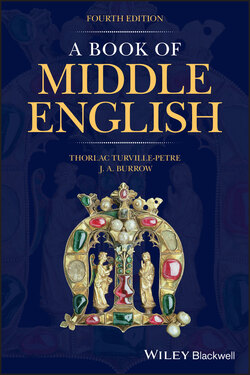A Book of Middle English

Реклама. ООО «ЛитРес», ИНН: 7719571260.
Оглавление
J. A. Burrow. A Book of Middle English
Table of Contents
Guide
Pages
A BOOK OF MIDDLE ENGLISH
List of Illustrations
Preface to the Fourth Edition
Abbreviations
1 Introducing Middle English. 1.1 The Period
1.1.1 From Old to Middle English
1.1.2 From Middle to Modern English
1.2 Varieties of Middle English
1.2.1 Regional Dialects
1.2.2 Early and Late Middle English
1.2.3 Spelling
2 Pronouncing Middle English. 2.1 Introduction
2.2 Vowels. 2.2.1 The Long Vowels
2.2.2 The Short Vowels
2.2.3 Unstressed Final ‐e
2.2.4 The Diphthongs
2.3 Consonants
2.4 Stress
3 Vocabulary. 3.1 Introduction
3.2 Scandinavian
3.3 English, French and Latin
3.4 Latin Loan‐Words
3.5 French Loan‐Words
4 Inflexions. 4.1 Introduction. 4.1.1 The Inflexional System
4.1.2 Loss of Inflexional Endings
4.2 Nouns. 4.2.1 Introduction
4.2.2 Noun Inflexions: Early Southern Texts
4.2.3 Developments in Noun Inflexions
4.2.4 Genitive Singular Without Ending
4.2.5 Unchanged Plurals
4.2.6 Mutated Plurals
4.3 Pronouns and Articles. 4.3.1 Forms of the Personal Pronouns
4.3.2 First and Second Person Pronouns
4.3.3 Third Person Pronouns: Masculine and Neuter Singular
4.3.4 Third Person Pronouns: Feminine Singular
4.3.5 Third Person Pronouns: Plural
4.3.6 The Definite Article
4.3.7 Demonstratives
4.3.8 The Indefinite Article
4.4 Adjectives and Adverbs. 4.4.1 Definite and Indefinite Inflexions
4.4.2 Inflexions for Case
4.4.3 Comparison of Adjectives
4.4.4 Comparison of Adverbs
4.5 Verbs. 4.5.1 Introduction
4.5.2 Present Tense
4.5.3 Past Tense and Past Participle
4.5.4 Past of Weak Verbs
4.5.5 The Verbs ‘Have’ and ‘Say’
4.5.6 Past of Strong Verbs
4.5.7 Irregular Verbs
4.5.8 The Verb ‘To Be’
5 Syntax. 5.1 Gender
5.2 Number
5.3 Use of Cases. 5.3.1 Nominative and Accusative
5.3.2 Genitive
5.3.3 Dative
5.4 Pronouns and Articles. 5.4.1 Þou and ʒe
5.4.2 Non‐expression of Personal Pronouns
5.4.3 Man
5.4.4 Self
5.4.5 Reflexive Pronouns
5.4.6 Relative Pronouns
5.4.7 The Articles
5.5 Adjectives and Adverbs. 5.5.1 Position
5.5.2 Comparatives and Superlatives
5.5.3 Adjectives as Nouns
5.6 Verbs. 5.6.1 Use of Present Tense
5.6.2 Use of Past Tense
5.6.3 Auxiliaries of the Past
5.6.4 Auxiliaries of the Future: shall and will
5.6.5 The Infinitive
5.6.6 The Subjunctive
5.6.7 The Imperative
5.6.8 Impersonal Verbs
5.6.9 Verbs of Motion
5.6.10 The Passive
5.7 Negation
5.8 Questions
5.9 Word‐Order. 5.9.1 Inversion
5.9.2 The Object
5.9.3 Prepositions
5.9.4 Relative Clauses
5.9.5 Adverbial Phrases
5.9.6 Verb in Final Position
5.10 Recapitulation and Anticipation
6 Metre. 6.1 Introduction
6.2 Rhymed Verse
6.3 Alliterative Verse
6.4 Laʒamon’s Brut
7 From Manuscript to Printed Text
8 Translating Middle English
8.1 Trevisa’s Dialogue
8.2 Words and Their Meanings
8.3 Dictionaries
8.4 False Friends. 8.4.1 ‘lewd’
8.4.2 ‘kind’
8.4.3 Some Nouns and Verbs
8.5 Idioms
8.6 Translating Prose
Commentary
8.7 Translating Verse
Commentary
8.8 Translating Pearl
Commentary
9 Select Bibliography. 9.1 Bibliographies, Indexes, and Internet Resources
9.2 Language Studies
9.3 General Studies of the Literature
9.4 Studies of Particular Genres
9.5 Historical and Social Studies
1 The Peterborough Chronicle 1137
Editions
Facsimile
Study
2 The Owl and the Nightingale
Editions and Facsimile
Studies
Notes
3 Laʒamon: Brut
Editions
Studies
Notes
4 Ancrene Wisse
Editions
Facsimile
Translations
Studies
Notes
5 Sir Orfeo
Editions
Facsimile
Other Texts
Studies
Notes
6 The Cloud of Unknowing
Editions
Studies
Notes
7 William Langland: Piers Plowman
Editions
Facsimiles
Studies
(7a)
(7b)
Notes
8 Patience
Editions
Facsimiles
Studies
Notes
9 Sir Gawain and the Green Knight
Editions
Studies
Notes
10 Pearl
Editions
Studies
I
II
III
IV
V
VI
VII
VIII
Notes
11 St Erkenwald
Editions
Studies
Notes
12 John Trevisa: Dialogue between a Lord and a Clerk
Edition
Studies
Notes
13 John Gower: Confessio Amantis
Editions
Studies
Notes
14 Lyrics. a–f rawlinson lyrics
Editions
Studies
(a)
(b)
(c)
(d)
(e)
(f)
g–k harley lyrics
Editions
Facsimiles
(g)
(h)
(j)
(k)
l–r grimestone lyrics
Editions and Studies
(l)
(m)
(n)
(o)
(p)
(q)
(r)
Notes
15 The York Play of the Crucifixion
Edition
Facsimile
Studies
Notes
16 Geoffrey Chaucer: The Parliament of Fowls
Editions
General Studies
Editions
Facsimile
Studies
Notes
17 Chaucer: Troilus and Criseyde
Editions
Facsimile
Studies
Incipit Prohemium Secundi Libri
Explicit Prohemium Secundi Libri. Incipit Liber Secundus
Notes
18 Chaucer: The Canterbury Tales
Editions
Studies
18a Chaucer: The Reeve’s Tale
Studies
The Prologe of the Reves Tale
18b Chaucer: The Prioress’s Tale
Editions
Studies
The Proheme of the Prioresse Tale. Domine dominus noster
Here bigynneth the Prioresse tale of Alma redemptoris mater
Notes
Notes
19 Julian of Norwich: Revelations of Divine Love
Edition
Facsimile
Studies
Notes
Textual Notes
Glossary
WILEY END USER LICENSE AGREEMENT
Отрывок из книги
FOURTH EDITION
Thorlac Turville-Petre and J. A. Burrow†
.....
The verb has three moods: indicative, subjunctive and imperative. The distinction between indicative and subjunctive is explained later (5.6.6); broadly, it is that the subjunctive is a non‐factual mood, used to express a doubt, hypothesis, conjecture, wish or the like. The imperative is used for orders and requests.
In the indicative mood, verbs may distinguish in form between the first, second and third persons of the singular, but all verbs have just one form throughout the plural (for we, ʒe and hi/þei). The subjunctive has just one form throughout the singular, to which it adds ‐n throughout the plural.
.....